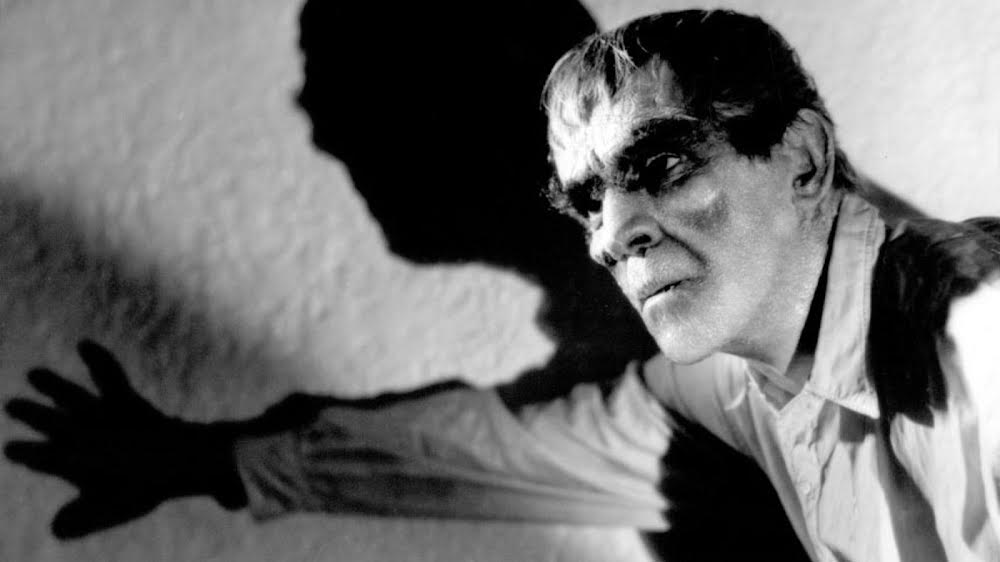As King Kong premiered at New York's Radio City Music Hall and Roxy Theater the evening of March 2, 1933, Boris Karloff was on a plane to catch the S.S. Paris there partly to make the second British horror film "The Ghoul" and partly to escape Hollywood. His relationship with Universal continued to be a torrid one between his acquired back injuries while playing The Creature in "Frankenstein" (1931) and his current issues attempting to raise his weekly salary from $750 to $1,000 during the depths of The Depression. Universal balked, yet surprised the actor with his transportation but was unable to give him expenses to spend other than $12 they accumulated from emptying the pay phones on the Universal lot.
"It was a perilous flight, the plane eluding Frankenstein-like lightning in a stormy night sky. It arrived late in New York, so a tugboat had to deliver Boris and Dorothy to the already set-sail Paris. On board they found actor crony James Gleason and his wife (Gleason himself en route to a film in London) and had a wonderful trip -- enjoying an on-board screening of the three Barrymores in Rasputin and The Empress, charging everything and arriving in England, as Dorothy put it, "with a spectacular bar bill."
[...]
"Back in England for the first time since his 1909 exile, Boris enjoyed a major star reception, was too excited to sleep, took in the theatre and clubs, charmingly gave autographs to the crowds that pursued him, and, after all of these years, visited his brothers -- all distinguished members of the consular service. One of Boris's favorite stories for the rest of his life was how he dreaded a photographer's requesting a picture of him with his siblings at a London reception. Instead of deeming such a thing beneath their dignity, the Pratt brothers ("pleased as three boys!" recalled Karloff) all posed before a fireplace, excitedly arguing as to where each should stand.
""No sooner was the picture taken than all three brothers began to inquire how soon they would secure prints, and by the time I was in a positive glow of relief. A film actor had been received in the British diplomatic circles and made good!"" (Mank. Bela Lugosi and Boris Karloff: The Expanded Story of a Haunting Collaboration. 2009)
Karloff was Guamont's production-director Michael Balcon's only choice to play Professor Henry Morlant in the screen adaptation of the Frank King-Leonard J. Hines novel. Balcon had been put in charge of both Gaumont and Gainsborough Pictures, giving the higher brow productions to Gaumont and the lower to Gainsborough.
But producing "the second British film to deal with horrific themes" (The Ghoul (1933) - Articles - TCM.com) had advantages with the networking Balcon already had with the currently bankrupted German studio UFA GmbH after having sent a young Alfred Hitchcock there in 1925 for him to learn German Expressionist techniques. He would end up hiring many German immigrants onto his production team including the Austrian Director of photography Günther Krampf who had worked as a cameraman on F.W. Murnau's "Nosferatu" (1922) and G.W. Pabst's "Pandora's Box" (1929). Art director Alfred Junge and makeup man Heinrich Heitfield would also be added to the crew yet the director of "The Ghoul" ended up going to the American director Thomas Hayes Hunter who had been living in London since 1927.
The film was shot at Lime Grove Studios in Shepherd's Bush and was allocated a budget just over £30,000. But between the excessive demands from Krampf and Junge, the film came in under £40,000. It was released in London August 7th and then in the U.S. November 25th to lukewarm reviews. The New York Times described "The Ghoul" as "a newsreel of a Sunday school picnic would have been more thrilling." (BFI Screenonline: Ghoul, The (1933))
Karloff returned to Hollywood in June of 1933 to find his weekly salary was raised to $1,250 and an agreement was made with Universal allowing him to work outside of the horror genre and with other studios. Universal would call him back yet again in 1934 for his first collaboration with fellow horror actor Bela Lugosi in "The Black Cat."
"The Ghoul" would be screened multiple times up until 1938, the reels being considered lost as of the 1940s.
"In 1969, collector and horror film historian WIlliam K. Everson located a murky, virtually inaudible nitrate subtitled copy, Běs in Czechoslovakia. Though missing eight minutes of footage, it was thought to be the only copy left. [...] In the 1980s, a disused and forgotten film vault at Shepperton Studios was discovered behind a stack of wood. This was cleared and yielded the dormant nitrate camera negative in perfect condition. The British Film Institute took in The Ghoul, new prints were made and the complete version aired on TV on Channel 4 in the UK." (The Ghoul - UK, 1933 - reviews - MOVIES and MANIA)
The Ghoul will be playing on TCM Friday, October 9 @ 7:00 CST






No comments:
Post a Comment